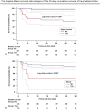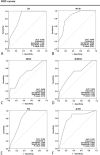Vascular Trauma in the Extremities: Factors Associated with the Outcome and Assessment of Amputation Indexes
- PMID: 35873125
- PMCID: PMC9295044
- DOI: 10.6515/ACS.202207_38(4).20220128A
Vascular Trauma in the Extremities: Factors Associated with the Outcome and Assessment of Amputation Indexes
Abstract
Background: Traumatic vascular injury in the extremities may be associated with a low mortality rate but can lead to limb loss that seriously affects patients' functionality. Multiple scoring systems have been designed to evaluate the prognosis, but none are 100% predictive. The management of traumatic vascular injury remains challenging and depends mostly on the surgeon's experience.
Objectives: We identified the risks associated with limb loss and further investigated the utility of current amputation indexes.
Methods: We retrospectively reviewed 53 cases of traumatic vascular injury in the extremities at a tertiary referral medical center over the past ten years (January 2011-December 2020). The mangled extremity severity score (MESS), limb salvage index (LSI), and predictive salvage index (PSI) were used to assess the traumatized limbs. The injury characteristics and outcomes were evaluated using regression analysis.
Results: The incidence of limb loss was 20.8% (n = 11), and open fractures were the most related factor. Extensive involvement of soft tissue, vascular injury combined with tibia or fibula fractures, initial shock status, and the amount of transfusion were associated with limb loss.
Conclusions: Our study identified the risk factors and clinical utility of MESS, PSI, and LSI. While both LSI and PSI had acceptable diagnostic accuracy, amputation should be decided based on a variety of criteria and clinical features. Salvaging any limb that has not become apparently futile seems logical, yet the presence of certain factors may suggest a worse outcome.
Keywords: Amputation index; Mangled extremity; Vascular trauma.
Figures



Similar articles
-
Reliability of the mangled extremity severity score in combat-related upper and lower extremity injuries.Indian J Orthop. 2015 Nov-Dec;49(6):656-60. doi: 10.4103/0019-5413.168759. Indian J Orthop. 2015. PMID: 26806974 Free PMC article.
-
Third degree open fractures and traumatic sub-/total amputations of the upper extremity: Outcome and relevance of the Mangled Extremity Severity Score.Orthop Traumatol Surg Res. 2016 Oct;102(6):785-90. doi: 10.1016/j.otsr.2016.04.004. Epub 2016 May 18. Orthop Traumatol Surg Res. 2016. PMID: 27209033
-
Utility of the Mangled Extremity Severity Score in Predicting Amputation in Military Lower Extremity Arterial Injury.Ann Vasc Surg. 2021 Jan;70:95-100. doi: 10.1016/j.avsg.2020.08.095. Epub 2020 Aug 29. Ann Vasc Surg. 2021. PMID: 32866576
-
The mangled extremity: assessment, decision making and outcomes.Acta Orthop Belg. 2021 Dec;87(4):755-760. doi: 10.52628/87.4.22. Acta Orthop Belg. 2021. PMID: 35172444 Review.
-
Mangled extremity: limb salvage for reconstruction versus primary amputation.Curr Opin Crit Care. 2023 Dec 1;29(6):682-688. doi: 10.1097/MCC.0000000000001108. Epub 2023 Oct 16. Curr Opin Crit Care. 2023. PMID: 37909372 Review.
Cited by
-
Analysis of the Risk Factors for Free Flap Necrosis in Soft Tissue Reconstruction of the Lower Limbs.Orthop Surg. 2023 Jun;15(6):1534-1540. doi: 10.1111/os.13727. Epub 2023 Apr 24. Orthop Surg. 2023. PMID: 37092532 Free PMC article.
References
-
- Ouriel K, Veith FJ. Acute lower limb ischemia: determinants of outcome. Surgery. 1998;124:336–341. - PubMed
-
- Popescu GI, Lupescu O, Nagea M, Patru C. Diagnosis and treatment of limb fractures associated with acute peripheral ischemia. Chirurgia (Bucur) 2013;108:700–705. - PubMed
-
- Green NE, Allen BL. Vascular injuries associated with dislocation of the knee. J Bone Joint Surg Am. 1977;59:236–239. - PubMed
-
- Halvorson JJ, Anz A, Langfitt M, et al. Vascular injury associated with extremity trauma: initial diagnosis and management. J Am Acad Orthop Surg. 2011;19:495–504. - PubMed
-
- Hafez HM, Woolgar J, Robbs JV. Lower extremity arterial injury: results of 550 cases and review of risk factors associated with limb loss. J Vasc Surg. 2001;33:1212–1219. - PubMed
LinkOut - more resources
Full Text Sources
Miscellaneous
